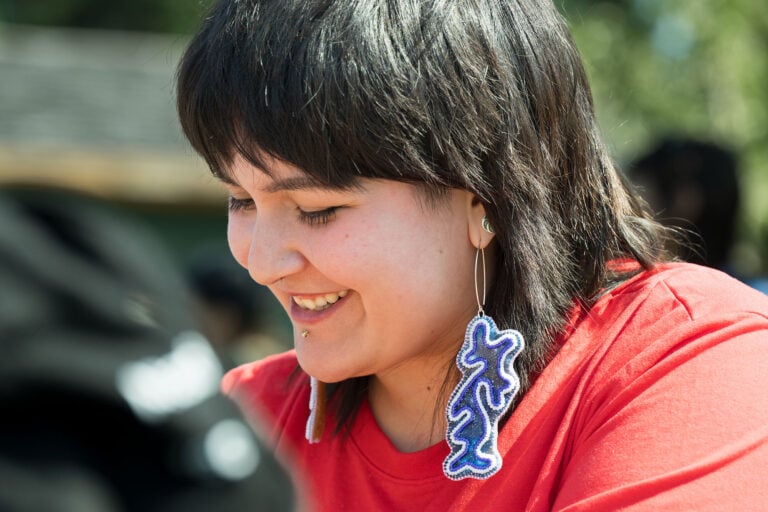
Curating an emerging voice
Teagyn Vallevand can’t wait to be an Elder. When she is, she’ll have all the time in the world for weaving. “I’ve been working on micro-weaving, mostly earrings,” she says, laughing that her work is a fraction the size…
By Amy Kenny
The first step in learning more is acknowledging what you don’t know. Casey Prescott, CEO of the Yukon Arts Centre, says that’s what staff did earlier this year when they talked to Lisa Dewhurst about accepting the newly created role of First Nations advisor to YAC.
“The reason we’re engaging with Lisa is that we have the humility to know that we don’t know what we should do,” says Prescott. “We’re looking for guidance and also creating more broad strokes so that we undoubtedly will discover things we didn’t even think of.”
Prescott says the role is one YAC has wanted to fill for 27 years, but that it needed to understand itself as an organization before it went ahead with filling the position. If YAC hadn’t been in as strong a place as it is now, it ran the risk of ending up with a booklet on a shelf rather than the strong guidance Dewhurst can offer.
Dewhurst, who is of the Nlaka’pamux nation of Merritt, B.C., lives in Teslin. There, she has been adopted into the Kukhittan Clan of the Teslin Tlingit (Raven Children) and has been given the Tlingit name of Keis.ey, which refers to the time just before the dawn breaks.
She has worked for more than a decade managing the Teslin Tlingit Heritage Centre. She stepped away from the role in August 2019 to focus on developing other initiatives and opportunities, including curating a travelling exhibition of Yukon First Nations’ graduation regalia in 2020.
Despite her experience, Dewhurst shies away from her new title at YAC.
“I kind of liken this role more to First Nations officer,” she says. “I definitely wouldn’t say I’m an expert on all First Nations within the territory, but I do bring an awareness and respect to the role.”
In that role, Dewhurst will reach out to rural communities and act as a resource for staff and the board of YAC. Though Prescott says YAC is wary of being too prescriptive about what her day-to-day looks like.
“We are kind of playing it by ear strategically,” he says. “Lisa has been great in helping us realize, ‘let’s not have firm deliverables, this will be two parts discovery and one part delivery’ … she’s there as a sounding board and witness and really to help educate. This position is designed to kind of connect with everything we do (from staff structure, to board recruitment and governance) so we can be mindful and inclusive in every piece of our operation.”
Right now, the COVID-19 pandemic has slowed things down a bit. Dewhurst says she hasn’t been able to spend as much time as she’d like meeting with the staff at YAC.
“Unfortunately, building a relationship you have to have human connection and sharing of food and conversation and it’s all so different right now.”
Still, she says it’s also been interesting to look at how that might change the way Yukoners engage with art in the coming year.
“Once the initial restrictions can be lifted and we are able to travel safely in the Yukon before the big floodgates open of international travel, there is such great opportunity this fall and early winter of coming together and getting to know each other better.”
She sees it as a chance for YAC to highlight local talent, and not just the well-knowns.
Dewhurst says she’d like to see attention paid to the kind of art that comes out of events such as the informal jam session that typically takes place in Teslin on July 1. Older residents come out with their guitars and you might not necessarily know them by their musical reputations, but there’s a pure sort of enjoyment and a spark in their eyes that Dewhurst says is amazing.
A few years ago, she saw a group exhibit at YAC (featuring, among others, Jeneen Njootli) that resonated with her because it had a similar quality. There was music and traditional clothing. Everything was exhibited in a way that was lively and interactive. It felt like the kind of sharing Dewhurst recognizes as being a big part of First Nations art.
“That’s what our art represents,” she says. “It’s such a celebration and it can’t be fully appreciated until it’s shared in a lively way, that we’re actually wearing the piece of art or we’re demonstrating how it works. We’re really tactile people we need to feel and smell to get the whole experience.”
When the territory opens again to Yukoners, that’s what she’d like to encourage more of.